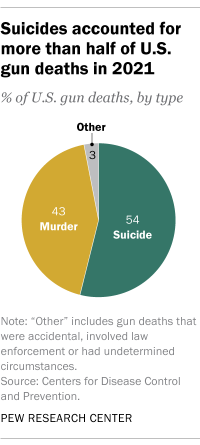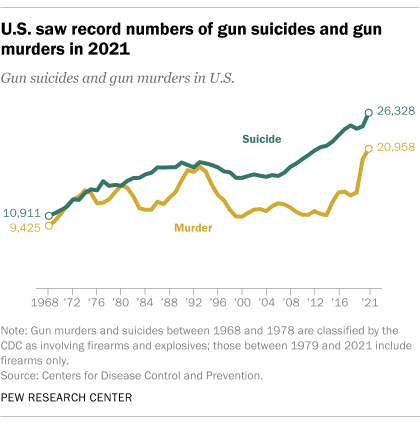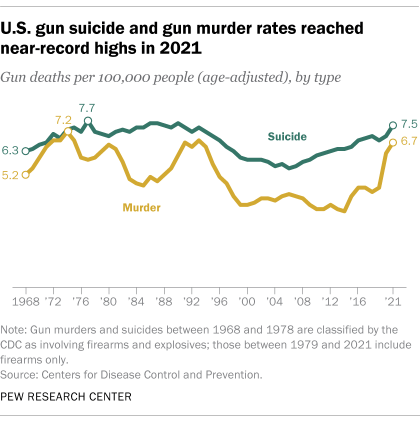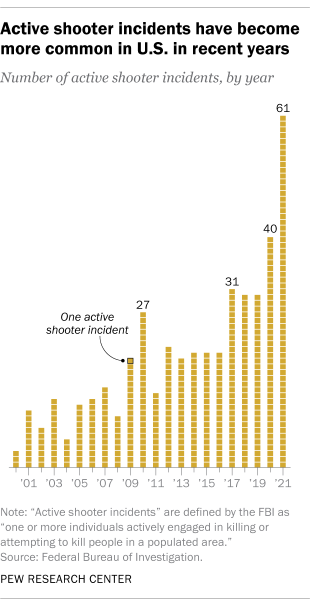More Americans died of gun-related injuries in 2021 than in any other year on record, according to the latest available statistics from the Centers for Disease Control and Prevention (CDC). That included record numbers of both gun murders and gun suicides. Despite the increase in such fatalities, the rate of gun deaths – a statistic that accounts for the nation’s growing population – remained below the levels of earlier decades.
Here’s a closer look at gun deaths in the United States, based on a Pew Research Center analysis of data from the CDC, the FBI and other sources. You can also read key public opinion findings about U.S. gun violence and gun policy.
This Pew Research Center analysis examines the changing number and rate of gun deaths in the United States. It is based primarily on data from the Centers for Disease Control and Prevention (CDC) and the Federal Bureau of Investigation (FBI). The CDC’s statistics are based on information contained in official death certificates, while the FBI’s figures are based on information voluntarily submitted by thousands of police departments around the country.
For the number and rate of gun deaths over time, we relied on mortality statistics in the CDC’s WONDER database covering four distinct time periods: 1968 to 1978, 1979 to 1998, 1999 to 2020, and 2021. While these statistics are mostly comparable for the full 1968-2021 period, gun murders and suicides between 1968 and 1978 are classified by the CDC as involving firearms and explosives; those between 1979 and 2021 are classified as involving firearms only. Similarly, gun deaths involving law enforcement between 1968 and 1978 exclude those caused by “operations of war”; those between 1979 and 2021 include that category, which refers to gun deaths among military personnel or civilians due to war or civil insurrection in the U.S. All CDC gun death estimates in this analysis are adjusted to account for age differences over time and across states.
The FBI’s statistics about the types of firearms used in gun murders in 2020 come from the bureau’s Crime Data Explorer website. Specifically, they are drawn from the expanded homicide tables of the agency’s 2020 Crime in the United States report. The FBI’s statistics include murders and non-negligent manslaughters involving firearms.
How many people die from gun-related injuries in the U.S. each year?
In 2021, the most recent year for which complete data is available, 48,830 people died from gun-related injuries in the U.S., according to the CDC. That figure includes gun murders and gun suicides, along with three less common types of gun-related deaths tracked by the CDC: those that were accidental, those that involved law enforcement and those whose circumstances could not be determined. The total excludes deaths in which gunshot injuries played a contributing, but not principal, role. (CDC fatality statistics are based on information contained in official death certificates, which identify a single cause of death.)

What share of U.S. gun deaths are murders and what share are suicides?
Though they tend to get less public attention than gun-related murders, suicides have long accounted for the majority of U.S. gun deaths. In 2021, 54% of all gun-related deaths in the U.S. were suicides (26,328), while 43% were murders (20,958), according to the CDC. The remaining gun deaths that year were accidental (549), involved law enforcement (537) or had undetermined circumstances (458).
What share of all murders and suicides in the U.S. involve a gun?
About eight-in-ten U.S. murders in 2021 – 20,958 out of 26,031, or 81% – involved a firearm. That marked the highest percentage since at least 1968, the earliest year for which the CDC has online records. More than half of all suicides in 2021 – 26,328 out of 48,183, or 55% – also involved a gun, the highest percentage since 2001.

How has the number of U.S. gun deaths changed over time?
The record 48,830 total gun deaths in 2021 reflect a 23% increase since 2019, before the onset of the coronavirus pandemic.
Gun murders, in particular, have climbed sharply during the pandemic, increasing 45% between 2019 and 2021, while the number of gun suicides rose 10% during that span.
The overall increase in U.S. gun deaths since the beginning of the pandemic includes an especially stark rise in such fatalities among children and teens under the age of 18. Gun deaths among children and teens rose 50% in just two years, from 1,732 in 2019 to 2,590 in 2021.
How has the rate of U.S. gun deaths changed over time?
While 2021 saw the highest total number of gun deaths in the U.S., this statistic does not take into account the nation’s growing population. On a per capita basis, there were 14.6 gun deaths per 100,000 people in 2021 – the highest rate since the early 1990s, but still well below the peak of 16.3 gun deaths per 100,000 people in 1974.

The gun murder rate in the U.S. remains below its peak level despite rising sharply during the pandemic. There were 6.7 gun murders per 100,000 people in 2021, below the 7.2 recorded in 1974.
The gun suicide rate, on the other hand, is now on par with its historical peak. There were 7.5 gun suicides per 100,000 people in 2021, statistically similar to the 7.7 measured in 1977. (One caveat when considering the 1970s figures: In the CDC’s database, gun murders and gun suicides between 1968 and 1978 are classified as those caused by firearms and explosives. In subsequent years, they are classified as deaths involving firearms only.)
Which states have the highest and lowest gun death rates in the U.S.?
The rate of gun fatalities varies widely from state to state. In 2021, the states with the highest total rates of gun-related deaths – counting murders, suicides and all other categories tracked by the CDC – included Mississippi (33.9 per 100,000 people), Louisiana (29.1), New Mexico (27.8), Alabama (26.4) and Wyoming (26.1). The states with the lowest total rates included Massachusetts (3.4), Hawaii (4.8), New Jersey (5.2), New York (5.4) and Rhode Island (5.6).

The results are somewhat different when looking at gun murder and gun suicide rates separately. The places with the highest gun murder rates in 2021 included the District of Columbia (22.3 per 100,000 people), Mississippi (21.2), Louisiana (18.4), Alabama (13.9) and New Mexico (11.7). Those with the lowest gun murder rates included Massachusetts (1.5), Idaho (1.5), Hawaii (1.6), Utah (2.1) and Iowa (2.2). Rate estimates are not available for Maine, New Hampshire, Vermont or Wyoming.
The states with the highest gun suicide rates in 2021 included Wyoming (22.8 per 100,000 people), Montana (21.1), Alaska (19.9), New Mexico (13.9) and Oklahoma (13.7). The states with the lowest gun suicide rates were Massachusetts (1.7), New Jersey (1.9), New York (2.0), Hawaii (2.8) and Connecticut (2.9). Rate estimates are not available for the District of Columbia.
How does the gun death rate in the U.S. compare with other countries?
The gun death rate in the U.S. is much higher than in most other nations, particularly developed nations. But it is still far below the rates in several Latin American countries, according to a 2018 study of 195 countries and territories by researchers at the Institute for Health Metrics and Evaluation at the University of Washington.
The U.S. gun death rate was 10.6 per 100,000 people in 2016, the most recent year in the study, which used a somewhat different methodology from the CDC. That was far higher than in countries such as Canada (2.1 per 100,000) and Australia (1.0), as well as European nations such as France (2.7), Germany (0.9) and Spain (0.6). But the rate in the U.S. was much lower than in El Salvador (39.2 per 100,000 people), Venezuela (38.7), Guatemala (32.3), Colombia (25.9) and Honduras (22.5), the study found. Overall, the U.S. ranked 20th in its gun fatality rate that year.
How many people are killed in mass shootings in the U.S. every year?
This is a difficult question to answer because there is no single, agreed-upon definition of the term “mass shooting.” Definitions can vary depending on factors including the number of victims and the circumstances of the shooting.
The FBI collects data on “active shooter incidents,” which it defines as “one or more individuals actively engaged in killing or attempting to kill people in a populated area.” Using the FBI’s definition, 103 people – excluding the shooters – died in such incidents in 2021.
The Gun Violence Archive, an online database of gun violence incidents in the U.S., defines mass shootings as incidents in which four or more people are shot, even if no one was killed (again excluding the shooters). Using this definition, 706 people died in these incidents in 2021.
Regardless of the definition being used, fatalities in mass shooting incidents in the U.S. account for a small fraction of all gun murders that occur nationwide each year.
How has the number of mass shootings in the U.S. changed over time?

The same definitional issue that makes it challenging to calculate mass shooting fatalities comes into play when trying to determine the frequency of U.S. mass shootings over time. The unpredictability of these incidents also complicates matters: As Rand Corp. noted in a research brief, “Chance variability in the annual number of mass shooting incidents makes it challenging to discern a clear trend, and trend estimates will be sensitive to outliers and to the time frame chosen for analysis.”
The FBI found an increase in active shooter incidents between 2000 and 2021. There were three such incidents in 2000. By 2021, that figure had increased to 61.
Which types of firearms are most commonly used in gun murders in the U.S.?
In 2020, the most recent year for which the FBI has published data, handguns were involved in 59% of the 13,620 U.S. gun murders and non-negligent manslaughters for which data is available. Rifles – the category that includes guns sometimes referred to as “assault weapons” – were involved in 3% of firearm murders. Shotguns were involved in 1%. The remainder of gun homicides and non-negligent manslaughters (36%) involved other kinds of firearms or those classified as “type not stated.”
It’s important to note that the FBI’s statistics do not capture the details on all gun murders in the U.S. each year. The FBI’s data is based on information voluntarily submitted by police departments around the country, and not all agencies participate or provide complete information each year.
Note: This is an update of a post originally published on Aug. 16, 2019.
